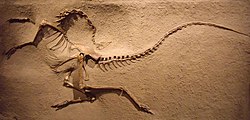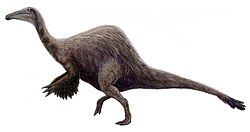
This timeline of ornithomimosaur research is a chronological listing of events in the history of paleontology focused on the ornithomimosaurs, a group of bird-like theropods popularly known as the ostrich dinosaurs. Although fragmentary, probable, ornithomimosaur fossils had been described as far back as the 1860s, [1] the first ornithomimosaur to be recognized as belonging to a new family distinct from other theropods was Ornithomimus velox , described by Othniel Charles Marsh in 1890. [2] Thus the ornithomimid ornithomimosaurs were one of the first major Mesozoic theropod groups to be recognized in the fossil record. [3] The description of a second ornithomimosaur genus did not happen until nearly 30 years later, when Henry Fairfield Osborn described Struthiomimus in 1917. [2] Later in the 20th century, significant ornithomimosaur discoveries began occurring in Asia. The first was a bonebed of "Ornithomimus" (now Archaeornithomimus ) asiaticus found at Iren Debasu. [3] More Asian discoveries took place even later in the 20th century, including the disembodied arms of Deinocheirus mirificus and the new genus Gallimimus bullatus . [3] The formal naming of the Ornithomimosauria itself was performed by Rinchen Barsbold in 1976. [2]
Contents
- 19th century
- 1860s
- 1890s
- 20th century
- 1900s
- 1910s
- 1920s
- 1930s
- 1960s
- 1970s
- 1980s
- 1990s
- 21st century
- 2000s
- 2010s
- 2020s
- See also
- Footnotes
- References
- External links
Early research into ornithomimosaur evolution was based on comparative anatomy. [2] In 1972, Dale Russell argued that the Jurassic Elaphrosaurus of Africa was an ancestral relative of ornithomimids. The descriptions of Garudimimus and Harpymimus in the 1980s revealed the existence of primitive ornithomimosaurs outside of the Ornithomimidae proper. [3] Subsequent research and discoveries during the 1990s refined science's knowledge of ornithomimosaur evolution. [2] In 1994, Pelecanimimus polyodon was described from Europe, the first known ornithomimosaur from that continent and apparently a very evolutionarily primitive taxon. From the late 1990s into the early 21st century cladistic evidence mounted against Russell's hypothesis that ornithomimosaurs were descended from a close relative of Elaphrosaurus, and favored an ancestry close to Pelecanimimus. Paleontologists found that within the theropod family tree, ornithomimosaurs were primitive coelurosaurs closely related to, but outside of, the maniraptorans. [3]
The juxtaposition of apparent evolutionary affinities to carnivorous dinosaurs with the possession of toothless beaks has led to controversy among paleontologists trying to reconstruct the diet of ornithomimosaurs. Osborn hypothesized in 1917 that ornithomimosaurs may have eaten plants, social insects, or aquatic invertebrates. In the 1970s paleontologists Russell, Halszka Osmolska, and her colleagues considered ornithomimosaurs carnivores that may have fed on insects, small vertebrates, or eggs. In the early to mid 1980s, however Russell and Elizabeth Nicholls began advocating a reinterpretation of ornithomimosaurs as herbivores. With the 1999 report of gastroliths in the new genus Sinornithomimus , came further support for reinterpreting ornithomimosaurs as herbivores or filter feeders rather than carnivores. [4] In 2001, Mark Norell reported a comb-like structure in the beak of Gallimimus that may have been used for filter feeding, bringing renewed credibility to one of Osborn's 1917 hypotheses. If this interpretation of the evidence is correct, Gallimimus would be the largest terrestrial filter feeder in history. [5]















